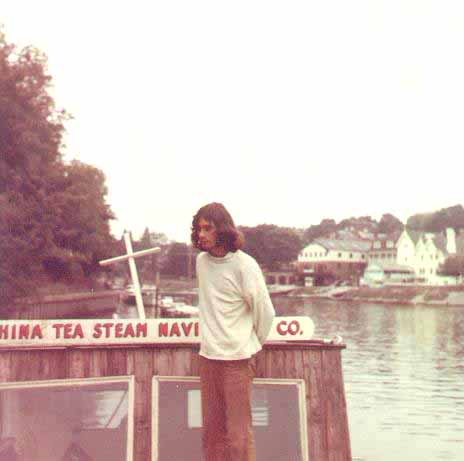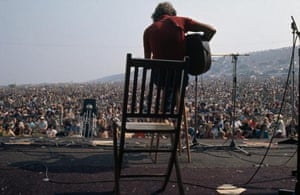This a chapter from my haibun/memoir. Listening to CBC Radio this morning I heard a news item about this year's line-up for the Glastonbury Music Festival and started reminiscing. I first published this in 1990 as a chapter in Eel Pie Dharma: a memoir/haibun with my poetry press Unfinished Monument. Tai Grove did a much more professional reprint with his Hidden Brook Press in 2012. We changed the title to Eel Pie Island Dharma: a hippie memoir/haibun so potential readers would know it wasn't a cookbook!
As always, special thanks to fellow Eel Pie Island communard Weed for posting this online in the early 2000s. Check out his websites.
EEL PIE DHARMA - a memoir / haibun - © 1990 Chris Faiers
Chapter 24 - Glastonbury Magic FestivalWord went out through the hippie grapevine of a magic festival to be held in Glastonbury. Glastonbury was a legendary sacred site in England, with a cathedral where one of the apostles had planted a rose bush which bloomed all the year round. Nearby loomed a mysterious conical hilltop, called a tor, which was rumoured to be hollow. Glastonbury Tor was said to be a 'sending station' on the system of ley lines, a power grid which lay over the English countryside, and which is the planet's equivalent of the magnetic fields which surround the human body which acupuncturists use.Jeremy and I had earlier visited another of these mysterious tors, Michael's Mount off the Cornish Coast. Another such tor is Mont San Michel off the French coast. In the olden days festivals were held to replenish the 'dragon power', or earth magic which kept fields fertile and the inhabitants prosperous. Supposedly the twelve signs of the zodiac were laid out around Glastonbury Tor, and from the small chapel on top of the Tor one could see the zodiac's unusual shapes blended in with the English countryside. This was an event not to be missed. The festival was to be held for the summer solstice, June 21, and I left my dossing friends in Cornwall and began to hitchhike. I got a ride as far as Salisbury, travelling quickly through the ancient fields of Stonehenge country. Walking through Salisbury, a hippie/student came up to me, and gave me a hit of acid wrapped in foil. He bragged how he and his mates had put hits of acid into the milk bottles which the local police used for their tea, and how that day a couple of cops had gone to hospital with hallucinations, while the other policemen wandered about in a happy daze all day, smiling at everyone. I thanked him for the acid, and not knowing what to do with it, and not wanting to be caught with it in my possession after hearing his story, I put the foil packet in my mouth and resumed hitching. Rides followed quickly. First a van full of black musicians on their way to a gig picked me up, hoping to score some dope. Then a mysterious business-type man in a sleek Jaguar told me to hop in. As we sped through the darkening evening his conversation became more and more questioning. He seemed to know a lot about the forthcoming festival, and was eager to know as much as I could tell him about it. I realized that I was beginning to babble, and then it occurred to me that the acid had been dissolving in my mouth, depite the tinfoil. So I was starting to trip, and at this point, speeding through the night, my mysterious driver told me he was the police chief for the area, and that he wanted to know what to expect from the festival goers. I tried to put his mind at ease, that we weren't going to be smuggling dope or sacrificing virgins. I also realized that I wanted to get out of the car before a full-blown acid trip took over. He let me out on the outskirts of Piltdown, after pointing me in the general direction of the farm where the festival would be held. I wandered down the lonely highway in the dark with only starlight to guide me. The white lines in the middle of the road began stretching and blurring in an effect I knew was the result of a mild acid trip, but the effects weren't overpowering. At the juncture with the road I was to follow the next day, I slipped into a field and fell asleep, exhaustion overcoming the weak acid dose. I awoke late the next morning, still feeling some effects from the acid, and lay in the field watching the clouds make incredible patterns in the clear blue sky. Finally excitement at the thought of the festival overcame my lethargy, and I started to walk down the country road. Surprisingly I got another ride, this time from a local who also had heard a lot about the festival. He was dubious about the quality of our hippie magic, as the weather had been overcast for the past few days. His tone wasn't ironic, and I realized how many of the British, especially in the countryside, still believe in magic and a lot of the Celtic mythologies. The road was becoming jammed with fellow festival goers, and when my ride let me out, I joined the throng. This was a more serious and committed type of hippie. We were the true believers for the most part, not just students growing their hair long for a wild summer. A local farmer let us use his fields, with his stone farmhouse as headquarters. By the time I got to the site it was dinner time, and some self-styled diggers had set up a kitchen beside the farmhouse in the barnyard. I ate some stew dippped from a huge iron pot, and soon was reviving old friendships with people from the Richmond scene and elsewhere. There was a magical excitement in the air, and the view over the festival site was typical of Somerset's hilly beauty. I wandered from the throng at the soup kitchen, and fell asleep on a hill in the middle of a field. A very odd snuffling noise awoke me very early the next morning:
Everyone was smoking dope and unloading trucks in a flurry of manic activity, and I joined in. I was proud of the muscles I had developed as a gravedigger, and I spent hours unloading scaffolding. After unloading, I joined the construction crews, and very quickly the pyramid began taking shape. One job I had to perch on a rail high in the air and saw off the end of a piece of pipe with a hacksaw. Halfway through the job, someone handed me a carrot carved into a chillum and stuffed with pungent hash. We were a crazy looking construction crew, but somehow through the haze of hash smoke, the pyramid grew skyward. Boards were laid for the performance area, about twenty feet off the ground, and the scaffolding continued to a peak about seventy feet above that. After working on the pyramid all day, I took off for a tour of the festival site. The farm was about a hundred acres, with hedgerows dividing the area into several major fields. Tents were appearing everywhere, and many hippies were building huts in the hedgerows. Banners and tents and colourful people were everywhere, like some medieval camp before battle. For a bunch of spaced-out freaks, things were amazingly well organized. Six-foot deep latrines were dug, and metal pipes were laid across them. Another free kitchen sprung up towards the bottom of the site, and everyone looked like they were going to be housed and fed. At the bottom of the hilly fields, the pyramid stretched into the sky, and after several days of building, the musical part of the festival was about to begin. I settled in a giant wigwam tent, at the bottom of the fields about a hundred yards from the pyramid. Quickly our tent became a family, and I met a blonde girl who hitched into Piltdown with me to buy food for our tribe. That night about ten of us dropped acid together while we sat huddled in blankets before the stage. Arthur Brown was the first performer, and he tried to bum people out. He sang about how the Aquarian dream was a fake, and that we should all examine our consciences. We countered his rock star negativity by staying in our group, and whenever one of us looked a little uncomfortable, the rest of us would put our arms over them and tell them they were in a big egg and about to be reborn. The positive group dynamics soon had us all on great acid trips, and we felt free to wander as a group. We danced and listened to the music under the stars with hundreds of other stoned worshippers, and all was at peace. Someone had gotten hold of a jug of scrumpy, a strong local cider, and that also helped ease any acid paranoias. Later in the evening, one of us had to take a dump, and so the whole gang of us dutifully trooped over to the open air latrines, and all of us sat in a long row on the poles and had a good shit or pee, men and women, young and old. It was one of the most liberating experiences of my life, all of us sitting there in the open air under the stars, making the natural and rude noises we all must make every day of our lives without any embarrassment. Some of us got the giggles from the acid, and the relaxing sound of laughter mixed well with the rock music and the sounds of nature. We all stumbled into the wigwam and fell asleep in each others' arms. I slept with the blonde girl, but we wanted to remain celibate to keep the spiritual atmosphere. In the middle of the night there was a commotion outside, and when we went to investigate, we noticed a giant shining star. On acid it hung in the sky like a space ship - it was the morning star, and we all stood in awe for several minutes. After a week of wandering in the fields, listening to music around campfires and eating with our fingers, we were incredibly dirty. I decided to walk the mile to a little pond where there were thirty or forty skinnydippers splashing around. I slipped off my dirty bellbottoms, and swam around in naked bliss, the water cool under the high afternoon sun. Late the next morning a hippie gave me a hit of acid, and then suggested we walk across the fields to Glastonbury Tor. It was a long hike, and after the usual hour the acid started coming on. It wasn't enough to overwhelm us, though. After several miles we came to a country road with a pub, and we stood and watched the swaying patterns the wind was making by sweeping through the ivy on the walls:
The festival had lasted over a week. It was much written about in the British musical and countercultural press, and I believe that the festival is still being held annually, almost twenty years after our inaugural event with the great pyramid. Eel Pie Dharma is protected by international copyright laws. Individuals may print off a copy of this work for personal use only to facilitate easier reading. |
Eel Pie Dharma - contents | previous chapter (23) | next chapter (25)
original Glastonbury Festival web page | official Glastonbury Festival web page
comments to weed@wussu.com
revised 8 March 2017
URL http://www.eelpie.org/epd_24.htm






